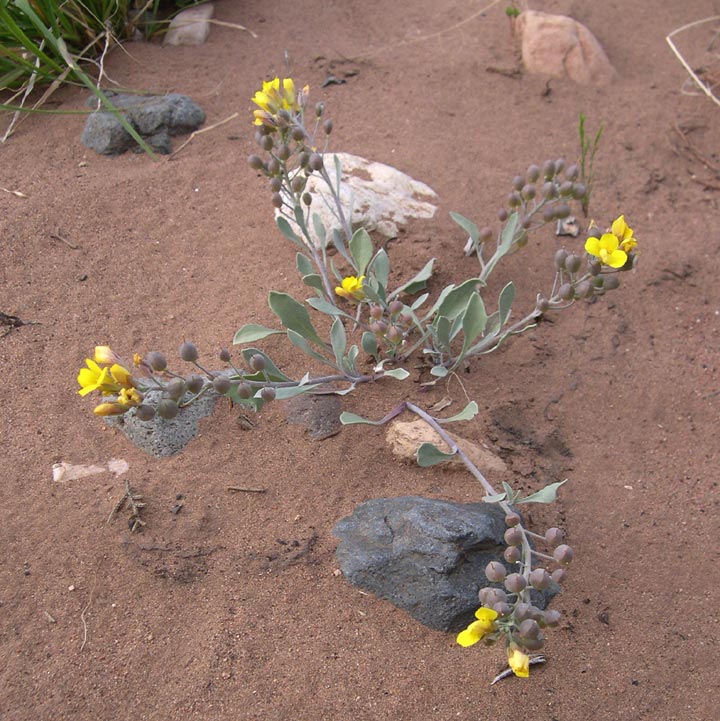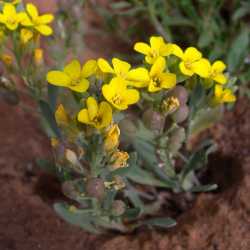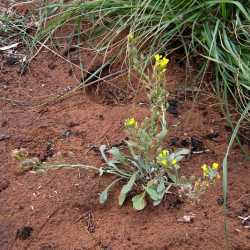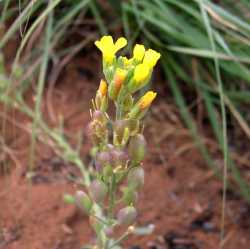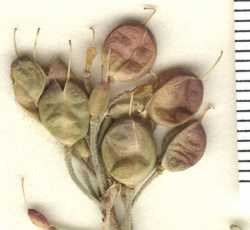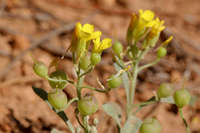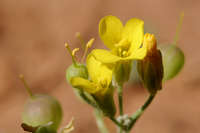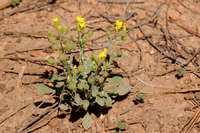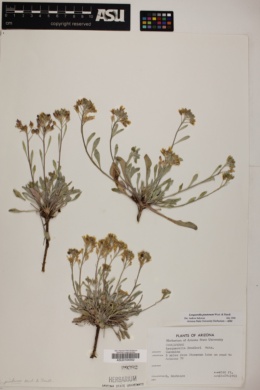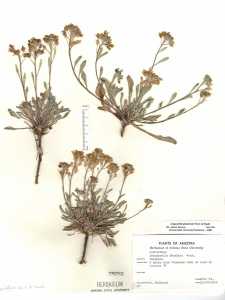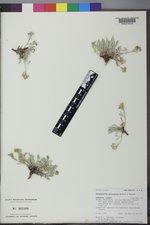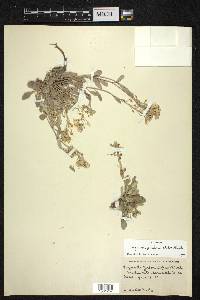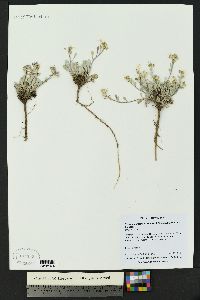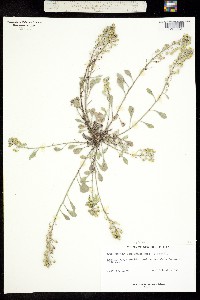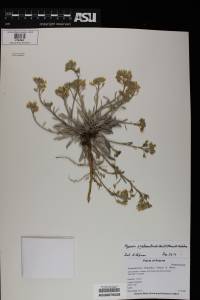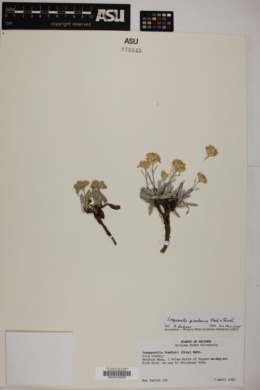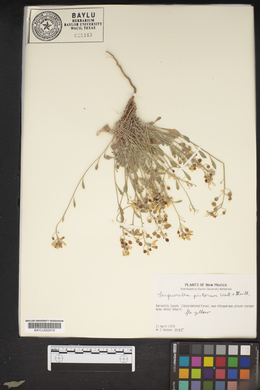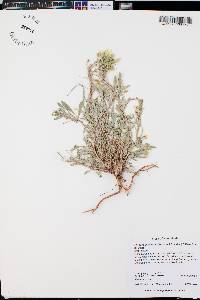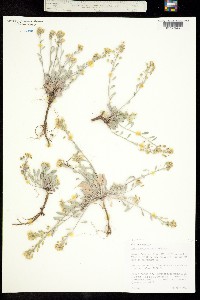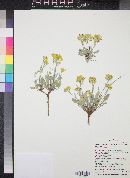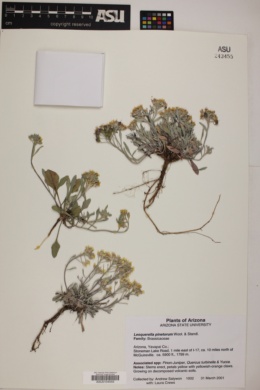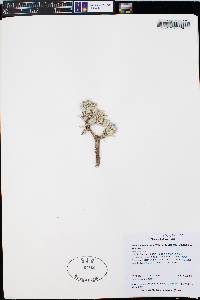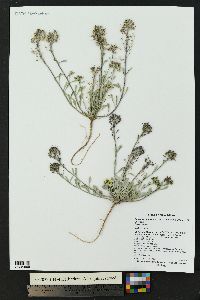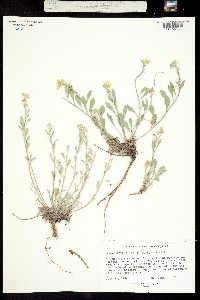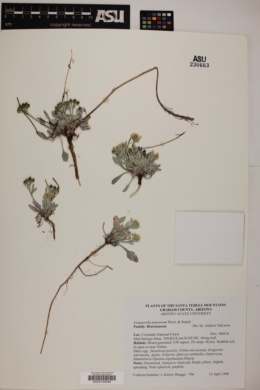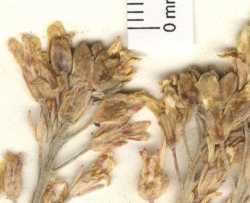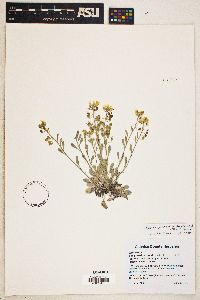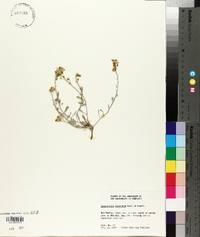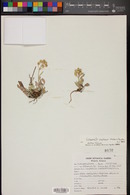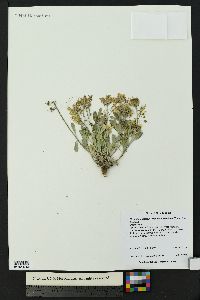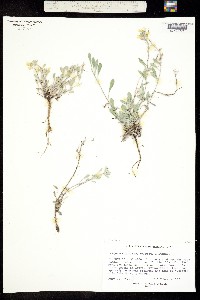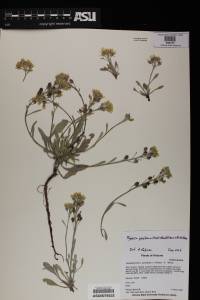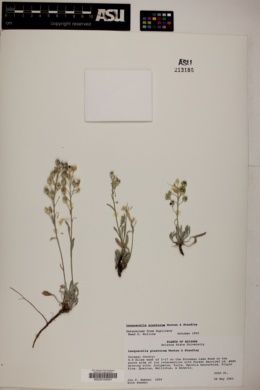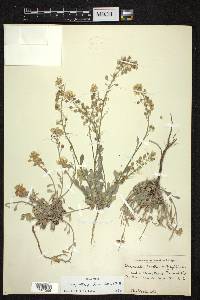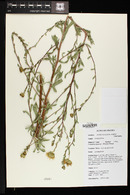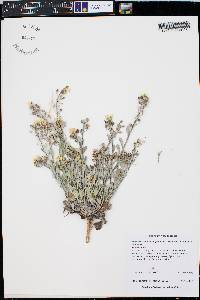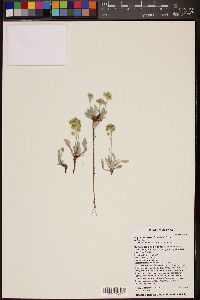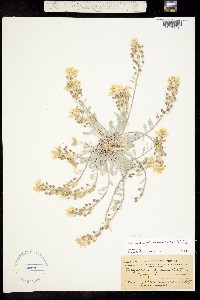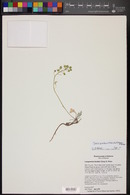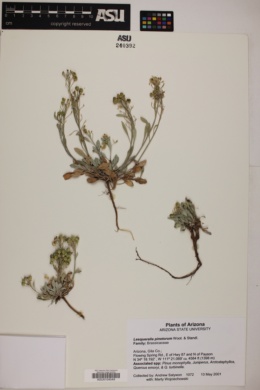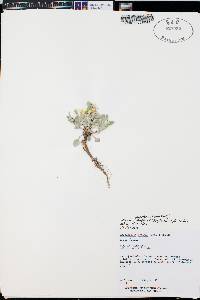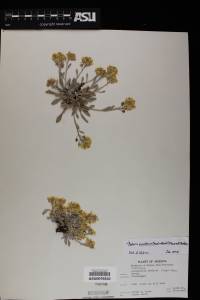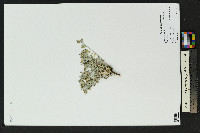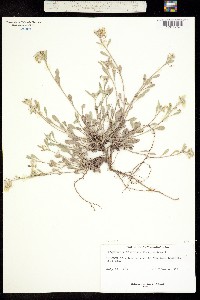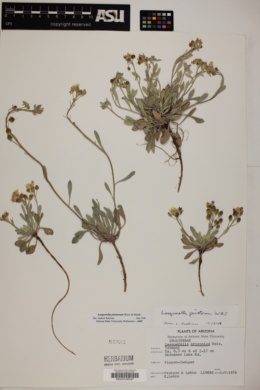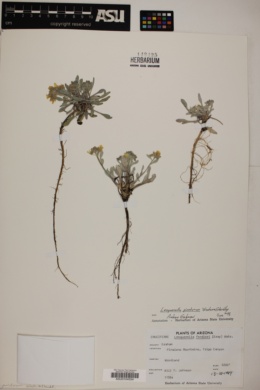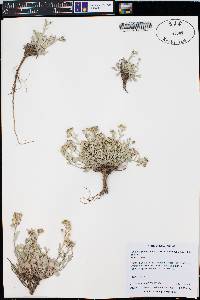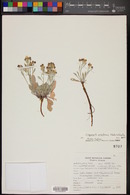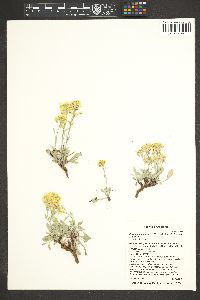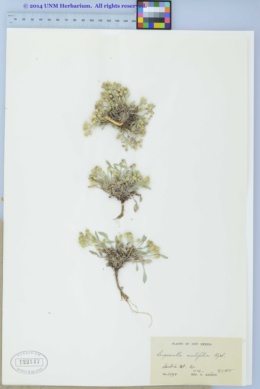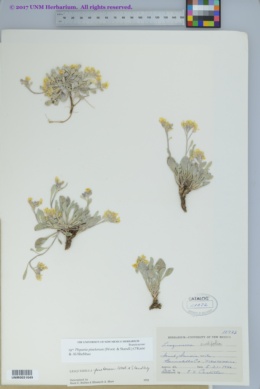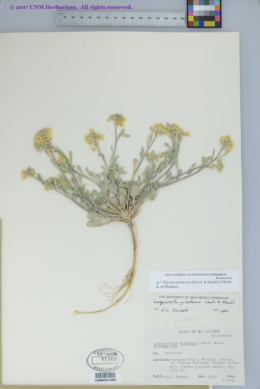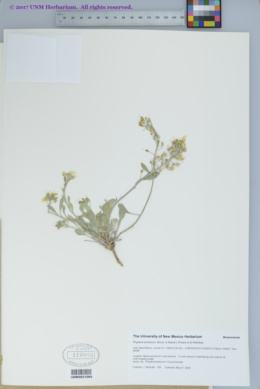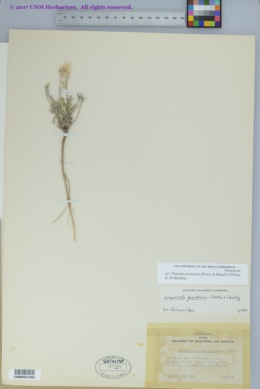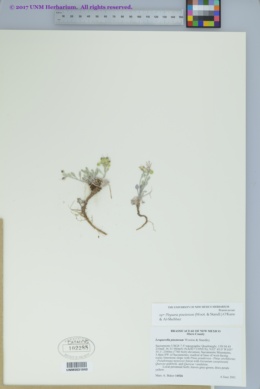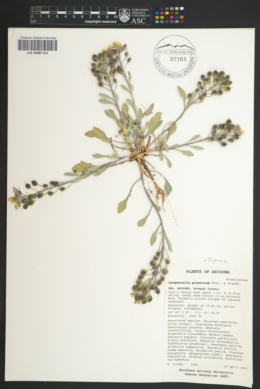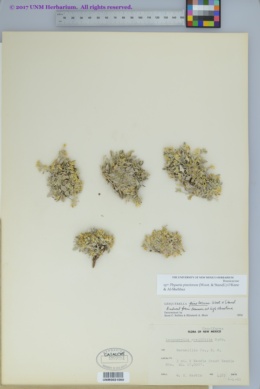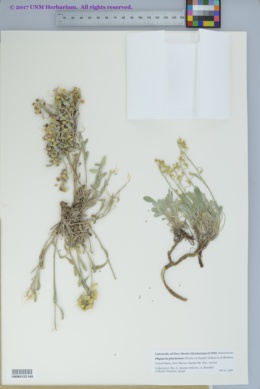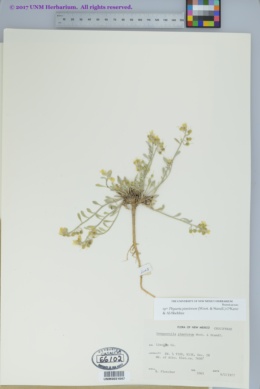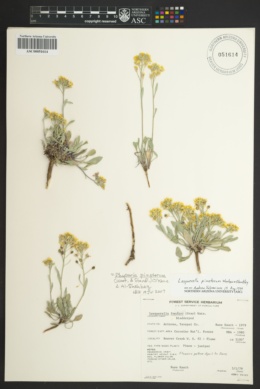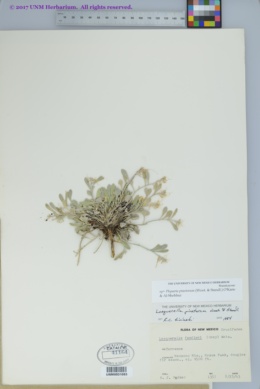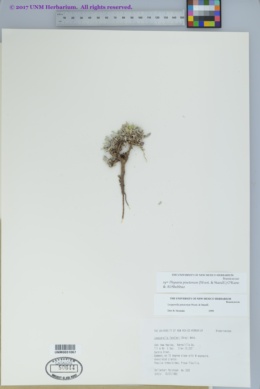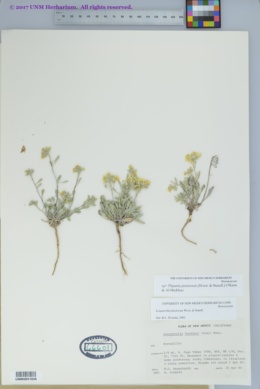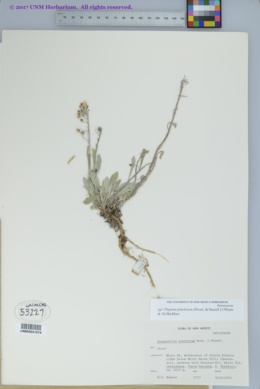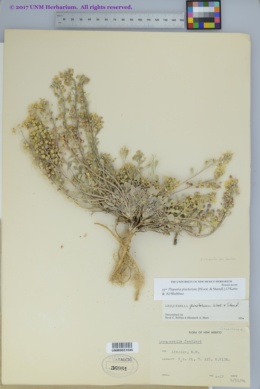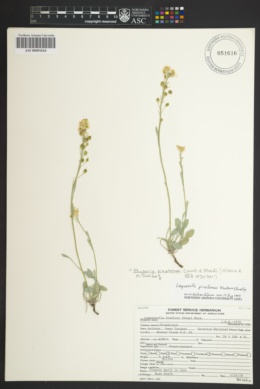
|
|
|
|
Family: Brassicaceae
White Mountain bladderpod, more...White Mountain Bladderpod
[Lesquerella pinetorum Woot. & Standl.] |
Perennials; caudex simple or branched; densely pubescent, trichomes (sessile or short-stalked), 6-8-rayed, rays furcate or bifurcate, (tuberculate, less so on outer layers). Stems simple or few from base, ascending to erect, (0.5-)1-2(-3.5) dm. Basal leaves: (petiole tapering to blade); blade rhombic to elliptic and irregularly angular, sometimes spatulate to oblanceolate, 1.5-7.5(-10) cm, margins entire. Cauline leaves: (not or loosely overlapping, petiolate or distal sessile); blade spatulate to oblanceolate, 1-4 cm, margins entire. Racemes crowded, elongated. Fruiting pedicels (ascending, curved or sigmoid), 6-12(-20) mm. Flowers: sepals ovate, oblong, or elliptic 4-7.5 mm, (median pair thickened apically, cucullate); petals spatulate or broadly cuneate, 6-13 mm, (claw slightly expanded at base). Fruits (substipitate), globose or obovoid to ellipsoid, sometimes slightly obcompressed, 4-9 mm; valves (not retaining seeds after dehiscence), glabrous throughout; replum as wide as or wider than fruit; ovules 4-24 per ovary; style (2-)4-7 mm. Seeds flattened. 2n = 10. Flowering Apr-Jul. Scrub oak, pinyon-juniper woodland, open ponderosa pine forests, these sometimes mixed with Douglas fir, white pine, white fir, Engelmann spruce, or Gambel oak, on limestone-derived or other-wise basic soils, often in rock crevices; 1400-2900 (-3400) m; Ariz., N.Mex. Physaria pinetorum with reduced forms are found at high elevations; in disturbed, moist soils plants can become quite large, as in the Manzano Mountains. Densely cespitose plants with crowded racemes not exceeding the basal leaves are found at the crest (3200-3400 m) of the Sandia Mountains, New Mexico. These probably represent an undescribed taxon.
FNA 2010, Allred and Ivey 2012 Duration: Perennial Nativity: Native Lifeform: Forb/Herb General: Perennial herb, 5-35 cm tall, from a simple or branched caudex; stems few, erect or ascending, unbranched; herbage densely pubescent with 6-8 rayed stellate hairs, some of the rays bifurcate (forked or branched). Leaves: Basal leaves petiolate; stem leaves alternate, sessile or short-petiolate; blades rhombic, spatulate, or oblanceolate, 1-10 cm long, the bases wedge-shaped and tapering into petioles, margins entire. Flowers: Yellow, in crowded to elongate racemes at branch tips; pedicels ascending in flower and fruit, curved or sigmoid, 6-20 mm long; sepals 4, oblong, 4-8 mm long; petals 4 in a cross formation, spatulate or broadly wedge-shaped, 6-13 mm long, yellow. Fruits: Capsules globose or obovoid to ellipsoid, 4-9 mm long, glabrous and inflated; topped with a persistent style 2-7 mm long; seeds flattened. Ecology: Found in limestone or otherwise basic soils, often in rock crevices, in scrub oak, pinyon-juniper woodland, and open ponderosa pine and mixed conifer forests, from 4,500-11,000 ft (1372-3353 m); flowers April-June. Distribution: AZ, NM Notes: Physaria species (until recently classified as Lesquerella) have gray-green leaves, often with stellate hairs; white or yellow 4-petaled flowers; and round, globe-shaped fruits with a persistent style attached to the tip. P. ovalifolia is distinguished by its cluster of long-petioled oval-shaped leaves at the base; few unbranched stems topped with racemes of yellow flowers; and relatively large globose pods, 0.5 to 1 cm long. This taxon can be quite variable in overall size. Reduced forms are found at high elevations, while the plants can become quite large in disturbed, moist soils. Densely cespitose plants with crowded racemes not exceeding the basal leaves are found at the crest of the Sandia Mountains in New Mexico, at 10,500-12,000 ft. These probably represent an undescribed taxon. Ethnobotany: Unknown, but other species in the genus have uses. Editor: AHazelton 2017 Etymology: Physaria comes from the Greek phusa or physa, "bellows" because of the inflated pod; pinetorum means associated with pine forest. |
|
|
|
This project was made possible in part by the Institute of Museum and Library Services [MG-70-19-0057-19].
Powered by Symbiota

